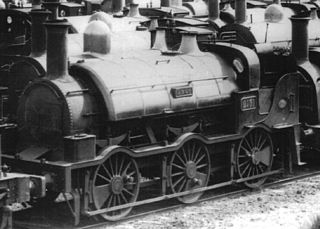The Rhymney Railway was a railway company in South Wales, founded to transport minerals and materials to and from collieries and ironworks in the Rhymney Valley of South Wales, and to docks in Cardiff. It opened a main line in 1858, and a limited passenger service was operated in addition.

The first Locomotives of the Great Western Railway (GWR) were specified by Isambard Kingdom Brunel but Daniel Gooch was soon appointed as the railway's Locomotive Superintendent. He designed several different 7 ft 1⁄4 in broad gauge types for the growing railway, such as the Firefly and later Iron Duke Class 2-2-2s. In 1864 Gooch was succeeded by Joseph Armstrong who brought his standard gauge experience to the workshops at Swindon. To replace some of the earlier locomotives, he put broad gauge wheels on his standard gauge locomotives and from this time on all locomotives were given numbers, including the broad gauge ones that had previously carried just names.

The Great Western Railway Metropolitan Class 2-4-0T broad gauge steam locomotives with condensing apparatus were used for working trains on the Metropolitan Railway. The equipment was later removed, though the class continued to work suburban trains on GWR lines in London. The class was introduced into service between June 1862 and October 1864, and withdrawn between June 1871 and December 1877.
The Great Western Railway (GWR) Bogie Class 4-4-0ST were broad gauge steam locomotives for passenger train work. The first two locomotives of this class were introduced into service in August/September 1849, with the remainder following between June 1854 and March 1855. All but one were withdrawn between October 1871 and 1873, with the final locomotive being withdrawn in December 1880.
The West Cornwall Railway was a railway company in Cornwall, Great Britain, formed in 1846 to construct a railway between Penzance and Truro. It purchased the existing Hayle Railway, and improved its main line, and built new sections between Penzance and Hayle, and between Redruth and Truro, and opened throughout in 1852.
The Comet class were 12 4-4-0 saddle tank broad gauge locomotives operated on the South Devon Railway and associated railways. They were designed for passenger trains on this steep and sharply curved line but were also used on goods trains when required.
The four Tornado class locomotives were 0-6-0ST broad gauge locomotives operated on the South Devon Railway and associated railways. They were designed for goods trains but were also used on passenger trains when required.

The eight Dido class locomotives were 0-6-0ST broad gauge locomotives operated on the South Devon Railway and Cornwall Railway and associated other adjacent railways. They were designed for goods trains but were also used on passenger trains when required.
The 26 Bristol and Exeter Railway 4-4-0ST locomotives were broad gauge 4-4-0 saddle tank steam locomotives. They first entered service in 1855 and the last was withdrawn in 1892. The Bristol and Exeter Railway was amalgamated into the Great Western Railway on 1 January 1876.
The Bristol and Exeter Railway 0-6-0 locomotives include three different types of broad gauge and standard gauge 0-6-0 steam locomotives designed for working freight trains. On 1 January 1876 the Bristol and Exeter Railway was amalgamated with the Great Western Railway, after which the locomotives were given new numbers.
The Bristol and Exeter Railway 2-4-0 locomotives were two classes of 2-4-0 broad gauge steam locomotives.
The Vale of Neath Railway was a broad gauge railway company, that built a line from Merthyr Tydfil and Aberdare to Neath, in Wales, chiefly to transport the products of the Merthyr iron industries to ports on Swansea Bay.
The nine Vale of Neath Railway 4-4-0ST locomotives were broad gauge 4-4-0 saddle tank steam locomotives. The first entered service in 1851 and the last was withdrawn in 1872. The Vale of Neath Railway was amalgamated into the Great Western Railway on 1 February 1865, but the locomotives retained their old numbers.
The South Wales Mineral Railway was a railway built to serve collieries in the upper Afan Valley, and bring their output to a dock at Briton Ferry, in South Wales. It opened in stages, in 1861 and 1863. It was built on the broad gauge and had steep gradients, including a rope worked incline near Briton Ferry.
The South Wales Railway was a main line railway which opened in stages from 1850, connecting the Great Western Railway from Gloucester to South Wales. It was constructed on the broad gauge. An original aspiration was to reach Fishguard to engender an Irish ferry transit and transatlantic trade, but the latter did not materialise for many years, and never became an important sector of the business. Neyland was the western terminus of the line until 1906.
The Dulas Valley Mineral Railway was incorporated in 1862 to bring coal from the Onllwyn area north-east of Neath to the quays there, and in the following year was reconstituted as the Neath and Brecon Railway. The line was opened as far as Onllwyn in 1863.
William Grindley Craig was locomotive superintendent of the Manchester, Sheffield and Lincolnshire Railway from 1854–1859. He was present, as an expert witness, at an enquiry into "The Railway Catastrophe Near Dudley" in 1858. He was succeeded by Charles Sacre.

The Taff Vale Railway O4 class was a class of 0-6-2T steam tank locomotives designed by Tom Hurry Riches and introduced to the Taff Vale Railway in 1907. They were rebuilt with taper boilers and superheaters by the Great Western Railway (GWR) from 1924.
The Daniel Gooch standard gauge locomotives comprise several classes of locomotives designed by Daniel Gooch, Superintendent of Locomotive Engines for the Great Western Railway (GWR) from 1837 to 1864.

The Ely Valley Railway (EVR) was a broad gauge railway company in South Wales, which opened a mineral line between Llantrisant station on the South Wales Railway main line and pits at Mwyndy and Penrhiwfer in 1860.




